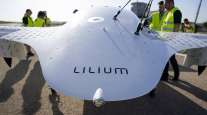Bloomberg News
How Drones Help Workers Inspect Wind Turbines

[Stay on top of transportation news: Get TTNews in your inbox.]
Last summer, at a wind farm close to Washington state’s southern border, an autonomous drone levitated 80 meters to the top of a wind tower and maneuvered along one of its blades. There, just near the tip, it detected a small gash — too small for the naked eye. Had it gone unrepaired, water and ice could have seeped in and frozen once the weather turned colder. That would have expanded the tear, causing more serious damage to the fiberglass blade.
Nearthlab, the Seoul-based company that designed the drone, had been hired to send its team to the wind park to inspect 132 towers. It says its drones use artificial intelligence and laser technologies to help pinpoint potential damage and reduce the chance of accidents during human inspections. The drones work quickly: They take 15 minutes to inspect a tower, compared with the day it takes a human technician to do the same using ropes and a harness. The towers have to be idled for the duration of the inspection, so the faster, the better.
Nearthlab’s drones use AI to navigate the wind towers. Once they reach the top, they take about a thousand photos of the blades and nacelle — which houses the turbine’s gearbox and brakes — to scan for potential defects and use laser technology to estimate the size and depth of any cracks. Once the images are saved on its servers, Nearthlab uses AI software to analyze the images and identify damage.
Amid the green-energy boom, cumulative wind capacity is forecast to double to 1.7 terawatts by the end of the decade, according to clean energy research group BloombergNEF. That has resulted in wind turbine service technicians being the fastest-growing job category in the U.S. The Bureau of Labor Statistics expects employment to grow about 60% over the decade that began in 2019.
While it might seem as though automated drones would put a damper on that growth, Bjorn Hedges, plant manager for the two Washington state wind farms inspected by Nearthlab, said he isn’t too worried about the technology becoming a threat. “With more wind turbines being built, the workload is increasing,” says Hedges, who works for NAES Corp. “There’s going to be little shortage of jobs.”
The facilities’ technicians are now free to perform tasks the drones can’t, Hedges says—a claim that’s a key part of Nearthlab co-founder Jay Choi’s sales pitch. “They can spend most of the time executing the repairs and doing a better job on the maintenance,” he says.
Choi, 34, a graduate of the Korea Advanced Institute of Science and Technology, started Nearthlab in 2015 after working at Doosan Heavy Industries & Construction Co., which builds nuclear and coal-fired facilities. While visiting construction sites, Choi saw the potential of drones to survey large-scale infrastructure.

Could this be the trucking industry’s roaring '20s? Business is booming, thanks, in part, to a slew of innovative technologies. With host Mike Freeze, we begin to wonder what’s next? Hear a snippet above, and get the full program by going to RoadSigns.TTNews.com.
“I found out that one of the most difficult tasks on site was safety inspection,’’ Choi says. “Although these were necessary tasks, they pose a great threat to workers.’’
Today, Choi counts renewable energy companies Siemens Gamesa Renewable Energy SA and Pattern Energy among his company’s customers. Its drones have been put to work at about 40 wind farms across the U.S. and Canada, according to Nearthlab.
Nearthlab says it’s developing flight control systems to prevent collisions when drones are flying in especially windy conditions, such as offshore wind parks. The company said its integrating sensor technologies that collects data from multiple sensors such as cameras and lidar — a laser imaging system used by some autonomous cars — to produce more accurate images.
Performing these inspections may help to maintain and extend the longevity of wind turbine blades. Old blades often end up in landfills because they can’t be recycled. In Europe, about 25,000 tons of blades a year will be decommissioned by 2025, climbing to 52,000 tons a year by 2030, industry group Wind Europe said last month.
Want more news? Listen to today's daily briefing below or go here for more info:




